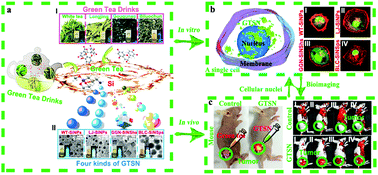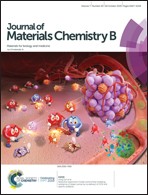Controllable silicon nanostructures featuring stable fluorescence and intrinsic in vitro and in vivo anti-cancer activity†
Abstract
In this manuscript, we demonstrate that the in situ growth of fluorescent silicon (Si) nanomaterials is stimulated when organosilicane molecules interact with different green teas, producing multifunctional Si nanomaterials with controllable zero- (e.g., nanoparticles), two- (e.g., nanosheets), and three- (e.g., nanospheres) dimensional nanostructures. Such green tea-originated Si nanomaterials (GTSN) exhibit strong fluorescence (quantum yield: ∼19–30%) coupled with ultrahigh photostability, as well as intrinsic anti-cancer activity with high specificity (e.g., the GTSN can accurately kill various cancer cells, rather than normal cells). Taking advantage of these unique merits, we further performed systematic in vitro and in vivo experiments to interrogate the mechanism of the green tea- and GTSN-related cancer prevention. Typically, we found that the GTSN entered the cell nuclei and induced cell apoptosis/death of cancer cells. The prepared GTSN were observed in vivo to accumulate in the tumour tissues after 14-d post-injection, leading to an efficient inhibition of tumour growth. Our results open new avenues for designing novel multifunctional and side-effect-free Si nanomaterials with controllable structures.



 Please wait while we load your content...
Please wait while we load your content...